Top 3 Most Common Kids’ Foot Problems – The Best Kids’ Shoes for Flat Feet, Rolled Ankles, and Toe-Walking
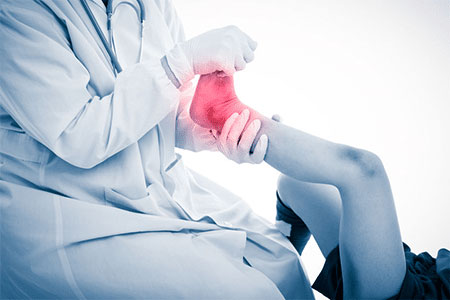
Do you have a child who is complaining about foot pain? There might be several reasons why your children complain about foot pain, but one thing is clear, pain is not normal, and when children experience pain, their bodies are telling us that there is a problem. As a passionate shoe fitter, I know for a fact that supportive shoes can make a significant difference in helping treat and prevent the top three most common foot problems in children: flat feet, toe walking, and weak ankles.
Being Proactive and the Role of the “Golden Years”
The first seven years of a child’s life, often referred to as the “golden years of treatment opportunity,” are crucial for addressing and potentially correcting common foot issues. During these formative years, the bones, muscles, and ligaments in a child’s feet are still developing, making them more malleable and responsive to corrective measures.
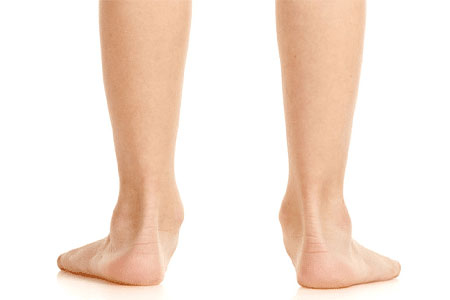
I have spoken to several families who took their children to their medical professional due to their kids’ foot pain, but they were told not to worry, and that their child will eventually outgrow the pain. I always recommend parents to be proactive and don’t take the “wait and see approach” when it comes to treating their children’s foot conditions. Leaving your children’s foot conditions untreated can only lead to the condition getting worse.
Foot Problem Number One: Flat Feet
This is the most common foot problem in children. One of the most common reasons why children experience foot pain is from having flat feet. This type of foot is relatively common in children, especially in toddlers. Most toddlers are flat-footed since their arch can develop until the age of five, and no intervention is required unless the toddler starts complaining about foot pain or there are visible signs of poor posture.
Identifying Flat Feet
To identify flat feet in your child, observe their feet when they stand. If the entire sole of the foot touches the ground without any visible arch, they may have flat feet.

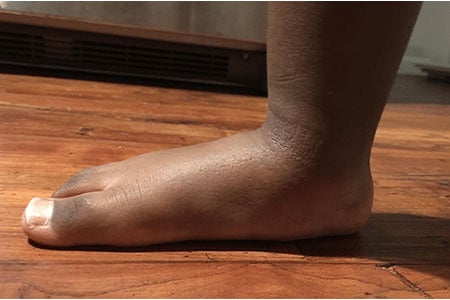
Treatment and Management of Flat Feet
The most effective way to treat children with flat feet is through supportive shoes. In certain cases, the child might need an orthotic for extra support to be fitted inside the shoes depending on the degree of the child’s flat feet. The correct type of shoes won’t mold your child an arch, but it will help your child walk and run straighter and improve your child’s overall posture.
Let me show you what a difference the correct pair of shoes can make in treating your child’s flat-footed condition. Below are a couple of images of flat-footed children standing barefoot and then wearing a pair of supportive shoes.

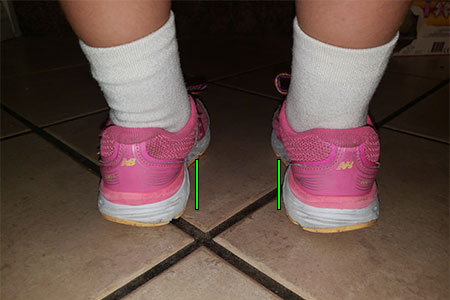
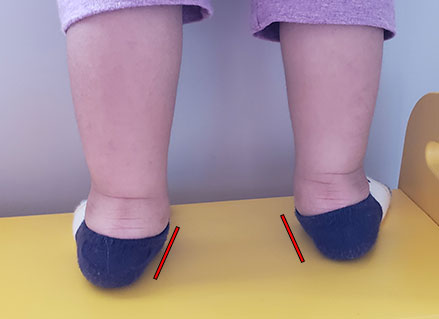
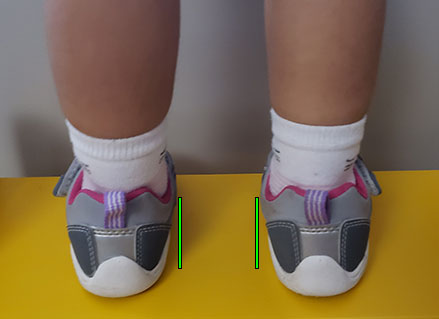
Supportive Shoes for Flat Feet
Supportive shoes for kids with flat feet are crucial. These shoes should have a firm heel counter, arch support, and a cushioned sole to provide stability and comfort. Arch support helps in distributing body weight evenly across the foot, reducing strain on the muscles and ligaments. I created a different resource that showcases a selection of the most supportive everyday sneakers for kids with flat feet.
Foot Problem Number Two: Weak Ankles
Weak ankles in children can be characterized by instability, frequent ankle rolls, or difficulty maintaining balance. This condition can be caused by loose ligaments or insufficient muscle strength around the ankle joint.

Identifying Weak Ankles
Children with weak ankles may frequently trip or fall, complain of ankle pain, or exhibit reluctance to participate in physical activities. These symptoms can be subtle, such as avoiding running games or expressing fatigue more quickly.
Treatment and Management
Shoes with firm heel counters and extra cushion right below the heels are essential for providing stability and support to your child’s ankles. This feature helps maintain proper alignment and prevents the foot from rolling inward or outward, which can lead to ankle sprains and other injuries.

Footwear for Children with Weak Ankles
Supportive shoes for children with weak ankles should have a high-top design, reinforced heel counters, and sturdy construction to provide the necessary ankle support. These features help in stabilizing the ankle joint and preventing excessive movement that can lead to injuries. I created a specific resource that has a list of supportive sneakers with firm heel counters for kids with weak ankles.
Foot Problem Number Three: Toe-Walking
Toe walking is a condition where a child walks on the balls of their feet, rather than with a heel-to-toe pattern. It is not uncommon in toddlers learning to walk, as they are still developing their balance and coordination. However, persistent toe walking beyond the toddler years can be a sign of an underlying issue.
Identifying Toe Walking
Toe walking can be observed when a child consistently walks on their toes, avoiding the heel making contact with the ground.
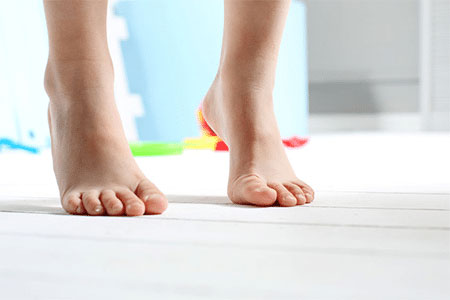
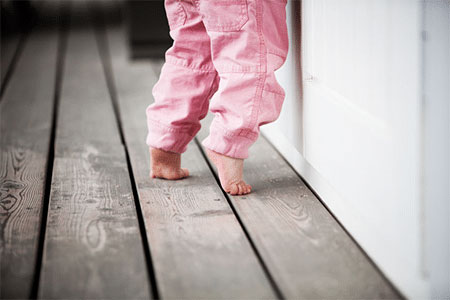
Treatment and Management
Treatment may involve a mixture of supportive shoes, orthotics, and physical therapy to stretch and strengthen muscles. In rare instances, surgery may be necessary to lengthen the Achilles tendon. Shoes that are rigid at the front instead of overly flexible are ideal to help treat and prevent toe walking.
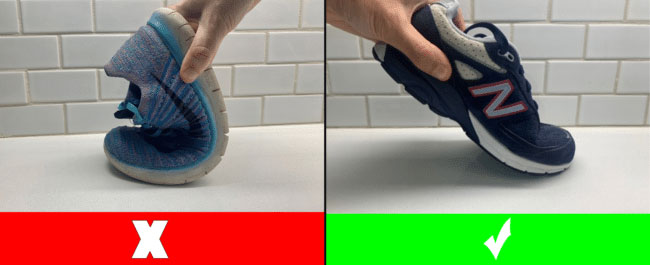
Footwear for Toe Walking
For children with toe walking tendencies, supportive shoes with a stable base of support, firm heel counters, and that are rigid at the front instead of overly flexible can help discourage toe walking. These shoe features encourage a heel-to-toe walking pattern and provide the stability needed to correct walking habits. You can access a list of rigid shoes that can help discourage toe walking in a different resource I created.
Personalized Shoe Recommendations
Every child’s foot shape and condition are unique, making personalized shoe recommendations vital. As a shoe fitter, I offer tailored advice to help families find the perfect pair of shoes for their child’s specific needs. Whether dealing with flat feet, toe walking, or weak ankles, the right footwear can significantly improve your child’s comfort and mobility. Feel free to contact me via email and I will recommend specific shoes tailored to your child’s unique foot shape and condition.
The Importance of Getting the Correct Shoe Size
Choosing the right shoe size is crucial in ensuring your child receives the full support and stability that supportive shoes have to offer. Ill-fitting shoes can exacerbate foot problems and lead to discomfort or injury. A shoe that is too small can restrict natural foot movement, while a shoe that is too large can cause blisters and reduce stability.

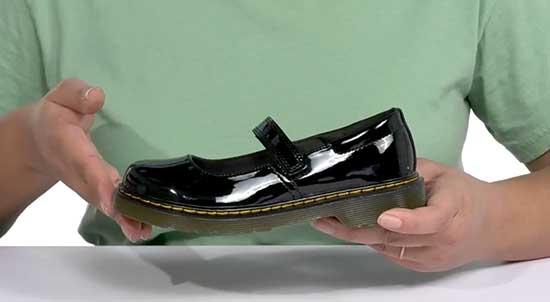
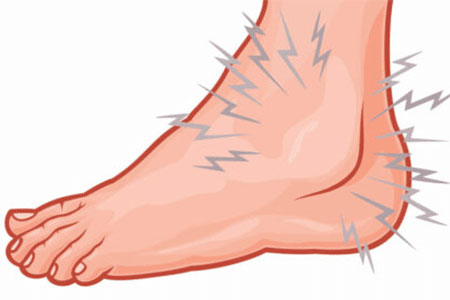

Hi! Thank you so much for your very informative articles! I have the same question as Sharon above, my daughter does overpronate and still does some tiptoe walking but has a narrow foot. She is 5 years old and wears a size 1 (little kids? The one that comes after 13 toddler). What supportive sneakers
and shoes would you recommend?
Thank you!
Hi Ailis,
For children with narrow feet I usually recommend Asics, but there are only a few Asics kids’ shoes that are effective in treating and correcting overpronation as well as toe walking. Below you can find my recommendations:
Option 1
Option 2
Make sure that you apply this shoe lacing technique once the shoes arrive:
How to Tie Shoes for Kids with Narrow Feet – Make their Shoes Fit and Feel Better!
I hope this helps.
Hello,
My daughter is 8 years old and still likes to walk on her toes when she is at home. What type of shoes do you recommend for her that she can wear in the home? She currently wears a size 2 in big kids.
Hello Davy,
I wrote several articles on toe walking children, and there are certain shoes that are really effective in preventing a child from walking on his/her toes. The longer time that your daughter can wear her sneakers, the better. If you want to allow your daughter to go barefoot around the house to give her a break from her shoes you can do so, just make sure it’s for no more than 3 to 4 hours. The longer that your daughter wears her sneakers, the better.
if you don’t know what shoes to provide to your daughter for everyday wear. please take a look at this article:
Shoes for Tip Toe Walking Children – Prevent Your Kids from Walking on Their Toes!
If you want your daughter to wear something different than her sneakers, there is a particular sandal that she can wear around the house:
Sandals for Toe Walking – Let’s Prevent Your Kids from Walking on Their Toes!
The rolled ankles/ overpronation describes my child perfectly! However, she also has very narrow feet (a D in UK widths and ‘Narrow’ in North American). What brands might accommodate this? You have NB for rolled ankles and ASICS and Saucony for narrow feet. Is there a brand for both?
Hello Sharon,
I don’t like to generalize and label one shoe brand as being the best one for a particular foot condition. Among each shoe brand, there are a few specific shoe styles that will help treat a child with rolled ankles/overpronation.
What is your daughter’s shoe size? That will help me send you specific shoe recommendations.